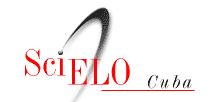Biomarcadores de estrés oxidativo en la enfermedad de Huntington y otros desórdenes neurológicos: estudio comparativo
Resumen
Objetivo: comparar biomarcadores de estrés oxidativo entre pacientes con enfermedad de Huntington y con otros desórdenes neurológicos.
Métodos: se realizó un estudio analítico, retrospectivo y caso-control (enfermedad de Huntington esclerosis lateral amiotrófica, ataxia espinocerebelosa tipo 2 e ictus isquémico: en etapa aguda y crónica). Se recogieron variables demográficas, clínicas y marcadores de daño oxidativo (malonildialdehído, productos avanzados de oxidación a proteínas) y antioxidantes (superóxido dismutasa: catalasa: glutatión peroxidasa, capacidad antioxidante del plasma).
Resultados: hubo diferencias significativas del malonildialdehído en la enfermedad de Huntington respecto al control (p=0,02), pero no con el resto de los grupos. La enzima superóxido dismutasa en enfermedad de Huntington fue menor estadísticamente en comparación con esclerosis lateral amiotrófica, aunque para la catalasa fue superior en relación con el resto de los pacientes. El FRAP en enfermedad de Huntington resultó menor significativamente versus esclerosis lateral amiotrófica e ictus isquémico agudo. Los productos avanzados de la oxidación de proteína se correlacionaron directamente con las edades biológicas y de inicio de la enfermedad de Huntington. La actividad motora en la esclerosis lateral amiotrófica y el déficit neurológico en el ictus isquémico agudo se correlacionaron con el malonildialdehído y glutatión peroxidasa respectivamente.
Conclusiones: la enfermedad de Huntington parece mostrar características específicas en su sistema antioxidante. La oxidación de proteínas pudiera estar relacionada con la acumulación de huntingtina mutada en el tiempo.
Palabras clave
Referencias
Marmolejo S, Casas C, Gitart R. Endogenous Mechanisms of Neuroprotection: To Boost or Not to Boost. Cells. 2021;10(2):370.
Bono J, Gómez AP, Millán JM, Vázquez RP. Reactive Species in Huntington Disease: Are They Really the Radicals You Want to Catch? Antioxidants (Basel). 2020;9(7):577.
Hansen JM, Jones DP, Harris C. The Redox Theory of Development. Antioxid Redox Signal. 2020; 32(10):715-740.
Zeun P, Scahill RI, Tabrizi SJ, Wild EJ. Fluid and imaging biomarkers for Huntington’s disease. Mol Cell Neurosci. 2019;97(10):67-80.
Serra JA, Domínguez RO, de Lustig ES, Guareschi EM, Famulari AL, Bartolomé EL, et al. Parkinson’s disease is associated with oxidative stress:comparison of peripheral antioxidant profiles in living Parkinson’s,Alzheimer’s and vascular dementia patients. J Neural Transm. 2001;108(10):1135-48.
Baillet A, Chanteperdrix V, Trocmé C, Casez P, Garrel C, Besson G. The Role of Oxidative Stress in Amyotrophic Lateral Sclerosis and Parkinson’s Disease. Neurochem Res. 2010;35(10):1530-7.
Serra JA, Domínguez RO, Marschoff ER, Guareschi EM, Famulari AL, Boveris A. Systemic oxidative stress associated with the neurological diseases of aging. Neurochem Res. 2009 ;34(12):2122-32.
Tang Q, Liu H, Shi XJ, Cheng Y. Blood Oxidative Stress Marker Aberrations in Patients with Huntington’s Disease: A Meta-Analysis Study. Oxid Med Cell Longev. 2020;91(87):195.
Peña M, Riverón G, Zaldívar T, Soto A, Borrero J, Lara G, et al. Association of status redox with demographic, clinical and imaging parameters in patients with Huntington’s disease. Clin Biochem. 2015;48(18):1258-63.
Krisko A, Radman M. Protein damage, ageing and age-related diseases. Open Biol. 2019;9(3):180249.
Medeiros MS, Schumacher A, Machado A, Vargas G, Baldissarelli J, Kegler A, et al. Iron and Oxidative Stress in Parkinson’s Disease: An Observational Study of Injury Biomarkers. PLoS One. 2016;11(1):e0146129.
Túnez I, Sánchez F, Agüera E, Fernández R, Sánchez FM, Tasset I. Important role of oxidative stress biomarkers in Huntington’s disease. J Med Chem. 2011;54(15):5602-6.
Hosaka T, Tsuji H, Tamaoka A. Biomolecular Modifications Linked to Oxidative Stress in Amyotrophic Lateral Sclerosis: Determining Promising Biomarkers Related to Oxidative Stress. Processes. 2021;9(9):1667.
Kolesnichenko LS, Kulinsky VI, Shprakh VV, Bardymov VV, Verlan NV, Gubina LP, et al. Glutathione System in Erythrocytes and Blood Plasma in Strokes and Dyscirculatory Encephalopathy. Biomed Khim. 2007;53(4):454-60.
Singh A, Kukreti R, Saso L, Kukreti S. Oxidative Stress: A Key Modulator in Neurodegenerative Diseases. Molecules. 2019;24(8):1583.
Enlaces refback
- No hay ningún enlace refback.
FINLAY EN: 








FINLAY CERTIFICADA POR:

Esta revista "no aplica" cargos por publicación en ninguna etapa del proceso editorial.
Dirección postal: Calle 51A y Avenida 5 de Septiembre Cienfuegos, Cuba Código postal: 55100.
http://www.revfinlay.sld.cu
Telefono: +53 43 516602. Telefax: +53 43 517733.
amgiraldoni@infomed.sld.cu
ISSN: 2221-2434
RNPS: 5129






